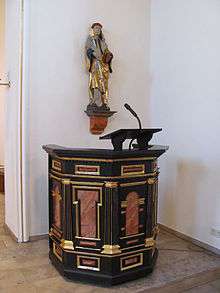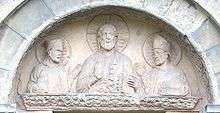Gotthard of Hildesheim
| Saint Gotthard | |
|---|---|
|
St. Gotthard as bishop, with the Hildesheim St. Mary relic receptacle; Basilica St. Godehard, Hildesheim | |
| Born |
960 Reichersdorf, Bavaria |
| Died | 4 May 1038 |
| Venerated in |
Roman Catholic Church Eastern Orthodox Church |
| Canonized | 1131, Rheims by Pope Innocent II |
| Feast | 4 May |
| Attributes | dragon; model of a church[1] |
| Patronage | travelling merchants; invoked against fever, dropsy, childhood sicknesses, hailstones, the pain of childbirth, and gout;[2] invoked by those in peril of the sea[3] |

Saint Gotthard (or Godehard) (960 – 4 May 1038 AD; Latin: Gotthardus, Godehardus), also known as Gothard or Godehard the Bishop, was an Anglo-German bishop venerated as a saint.
Life
Gotthard was born in 960 near Niederaltaich in the diocese of Passau. Gotthard studied the humanities and theology at Niederaltaich Abbey, where his father Ratmund was a vassal of the canons. While at the Abbey, Gotthard was placed under the guidance of Uodalgisus.[2] Gotthard then resided at the archiepiscopal court of Salzburg, where he served as an ecclesiastical administrator.[2] After traveling through various countries, including Italy, Gotthard completed his advanced studies under the guidance of Liutfrid in the cathedral school at Passau.[2] He then joined the canons at Niederaltaich in 990, and became their provost in 996.[2]
When Henry II of Bavaria decided to transform the chapter house of Niederaltaich into a Benedictine monastery Gotthard remained there as a novice, subsequently becoming a monk there in 990 under the abbot Ercanbertn. In 993, Gotthard was ordained a priest, in addition to becoming a prior and rector of the monastic school. In 996, when he was elected abbot, Gotthard introduced the Cluniac reforms at Niederaltaich.[2]
He helped revive the Rule of St. Benedict, which then provided abbots for the abbeys of Tegernsee, Hersfeld and Kremsmünster to restore Benedictine observance, under the patronage of Henry II, Holy Roman Emperor.
He became bishop of Hildesheim on 2 December 1022, being consecrated by Aribo, Archbishop of Mainz.[2] During the fifteen years of his episcopal government, while earning the respect of the clergy,[2] Gotthard ordered the construction of some thirty churches. Despite his advanced age, he defended the rights of his diocese vigorously.[2] After a brief sickness, he died on 4 May 1038.
Veneration

Gotthard's successors in the episcopate of Hildesheim, Bertold (1119–30) and Bernhard I (1130–53), pushed for his canonization.[2] This was accomplished during the episcopate of Bernard, in 1131, and it took place at a synod in Rheims. There, Pope Innocent II, in the presence of Bernard and Saint Norbert of Xanten, officially made Gotthard a saint.[2]
On 4 May 1132, Bernard translated Gotthard’s relics from the abbatial church to the cathedral at Hildesheim. On 5 May the first liturgical festivity in honor of Gotthard was celebrated. Miracles were attributed to the relics. Veneration of the saint spread to Scandinavia, Switzerland, and Eastern Europe. Gotthard was invoked against fever, dropsy, childhood sicknesses, hailstones, the pain of childbirth, and gout.[2]
Furthermore, Niederaltaich Abbey made its famous abbot the patron saint of the abbey's well-known grammar school, the St.-Gotthard-Gymnasium.
Gotthard also became the patron saint of traveling merchants, and thus many churches and chapels were dedicated to him in the Alps.[2] His hospice for travellers near Hildesheim (the "Mauritiusstift"), became famous.
According to an ancient Ticinese tradition, the little church in St. Gotthard Pass (San Gottardo) in the Swiss Alps was founded by Galdino, Archbishop of Milan (r. 1166-76). Goffredo da Bussero, however, attributes the founding of the church to Enrico di Settala, Bishop of Milan from 1213 to 1230.[2] The hospice was entrusted to the care of the Capuchin Order in 1685 by Federico II Visconti, and later passed under the control of a confraternity of Ticino.[2]
See also
Named after
Several places and events are named in honour of the Saint:
- Gothard is a popular surname.
- St. Gotthard Pass links Switzerland and Italy
- Szentgotthárd Abbey in Hungary
- Szentgotthárd, a Town in Hungary
- Battle of Saint Gotthard 1664. Part of the Austro-Turkish war
References
External links
| Wikimedia Commons has media related to Saint Godehard. |
- (German) Godehard (Gotthard) von Hildesheim
- "Gotthard of Hildesheim". Germania Sacra people index (in German). Göttingen Academy of Sciences and Humanities.
- Opening of the Godehard Shrine (video)
| Godehard of Hildesheim Born: 960 Died: 5 May 1038 | ||
| Catholic Church titles | ||
|---|---|---|
| Regnal titles | ||
| Preceded by Bernward |
Bishop of Hildesheim 1022–1038 |
Succeeded by Thiethmar |